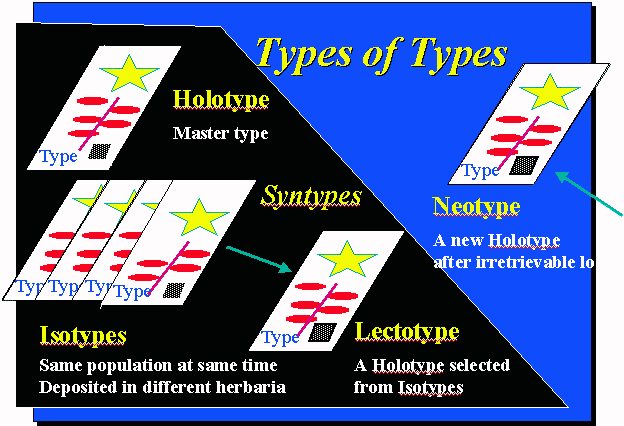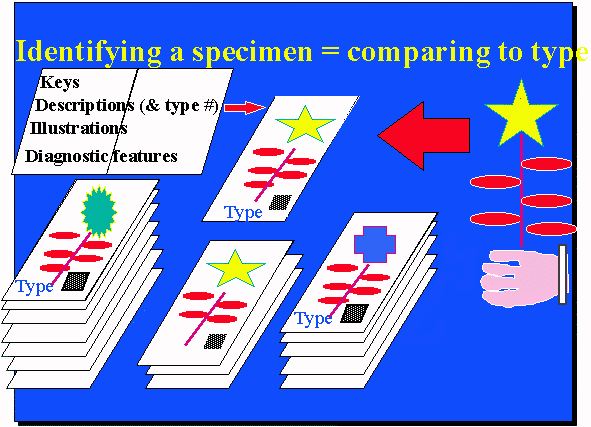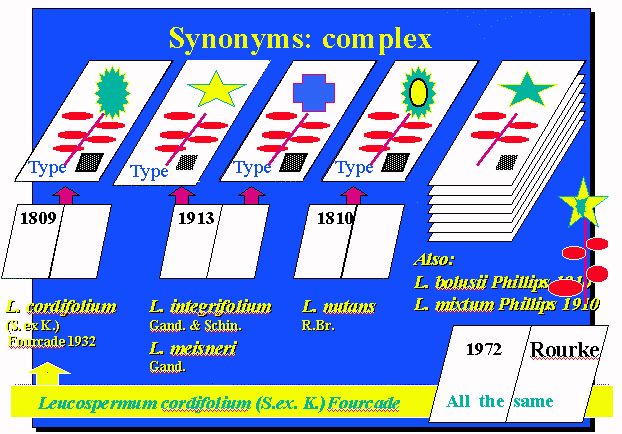
Home
Mission
Overview of Project
Project Staff
Sponsors
Achievements
Checking, Illustrations
Upcoming Activities
Id and Species Lists
Protea Information
Protea Gallery
Growing Proteas
Interim Dist. Maps
Publications
Afrikaanse Inligting
![]()
Why must taxonomists keep changing the names?
| Part of the enjoyment of botany is the understanding of, and history to, scientific names. Scientific names are given to plants according to a strict legal system known as taxonomy. In order to prevent confusion, a single specimen is designated the 'type' and given a binomial Latin name (the genus and species) which is published in a scientific journal. In the journal the name and type are both specified together with a short description of the type (in Latin). The type is the specimen to which all other specimens must be compared in order to ascertain if they are the same, and thus of the same species. |  |
Sometimes additional specimens (ideally from the same plant) are sent to other herbaria around the world. These "iso-types" are an insurance against loss of the "holo-type" by fire or war, and to expedite identification. The choice of the Latin name is left to the taxonomist describing the species, and usually refers to a feature of the species or to its collector.

Thus in Leucospermum cordifolium the genus is Leucospermum, the species is cordifolium, the type specimen was collected at Zwartberg by Zeyher (his collection number 3678b).

Strictly, the full name is Leucospermum cordifolium (Salisb ex Knight) Fourcade. This indicates that Joseph Knight originally published the specific name in 1809, quoting ('ex') from a manuscript of a friend, Richard Salisbury. In reality, Salisbury published the book under the name of his gardener, Knight: the description is on page 54 of 'On the cultivation of plants belonging to the natural order of the Proteaceae'. The brackets are used to indicate that Salisbury ex Knight had used a different generic name - Salisbury had called it Leucadendrum cordifolium (hence its full name up till the 1930's should have been Leucadendrum cordifolium Salisb ex Knight). It was Fourcade in 1932 (in the Transactions of the Royal Society of South Africa, Volume 21, page 97) who first attached the species name (and thus the type specimen) cordifolium Salisbury ex Knight to the genus Leucospermum.
We do not routinely include author's names in our newsletters, on the implicit understanding that we are using the most recent taxonomic revision, as summarized in Bond and Goldblatt (1984: Plants of the Cape Flora, a descriptive catalogue. South African Journal of Botany Suppl 13).
Amateur botanists are often puzzled by the complicated changes to plant names. This results in the sinking of often well known and interesting names to synonymy. Synonyms arise in a number of ways:
(1). When two type specimens (each having a validly published name) belong to the same species, then the older species name and type specimen becomes the correct name and type for that species. This situation may arise by accident when two taxonomists independently describe the same species, or when an 'unknown' older published name for the same species is discovered, or when taxonomists revise their concepts and sink several 'old species' into a single 'new species'.
(2). When by some oversight, a name is invalid. It may be a nomen nudum: a species described without a type. It may be illegitimate (nom. illegit.): a name already validly given to another type in the genus, or a new name for an already existing type, or (for plants only) a species name the same as that of the genus.
For example, John Rourke in 1972 revised the genus Leucospermum.
Based on his analyses he decided that the following types were
all the same (and therefore of the same species):
L. bolusii Phillips [1910],
L. cordifolium (Salisb ex Knight) Fourcade [1809,
1932],
L. integrifolium Gandoger & Schinz [1913],
L. meisneri Gandoger (1913],
L. mixtum Phillips [1910], and
L. nutans R.Br. [1810].

The 1809 specific name of cordifolium Salisb ex Knight, being the earliest, is therefore the valid name and the later names become synonyms. Note that each of these synonyms has a type and therefore is a validly published name. These are therefore "Type 1" changes. Note too how the generic name is abbreviated to its first letter when there is no chance of confusing abbreviations (when confusion may arise the generic name must be spelt out in full).
It is therefore perfectly valid to take a flowerhead, compare it to the type of L. nutans R.Br. and decide that the two are identical and therefore the flowerhead is L. nutans R.Br. It is also perfectly correct to use this name, because anyone can look up the name in John Rourke's revision and see perfectly well that this is the same as L. cordifolium (Salisb ex Knight) Fourcade. However, you may appreciate that it is excessively tedious to remember all five of the alternative species names for L. cordifolium (Salisb ex Knight) Fourcade, and so we might as well all agree to use the oldest name.
The Proteaceae have been particularly prone to "Type 1" changes. This is largely because of a feud between rival botanists in the 19th century: On the 17th January 1809 Robert Brown read a paper entitled 'On the Proteaceae of Jussieu' at the meeting of the Linnaean Society of London. Richard A. Salisbury, who sat in on the meeting, preempted Robert Brown by publishing his own treatise 'On the cultivation of the plants belonging to the natural order Proteeae', in 1809 under the guise of a friendly gardener, Joseph Knight. Due to a delay Robert Brown's paper was only published in 1810. The British botanical community was incensed by Salisbury's plagiarism, and decided to ignore his work. Quite unfairly so, as Richard Salisbury had obviously worked on the Proteaceae for a long time prior to attending Robert Brown's talk, even if he did borrow an idea or two. Salisbury's quarrelsome, acerbic nature probably contributed to his unpopularity.
Even the Flora Capensis, which dealt with all the plants in southern Africa in 1912, ignored Salisbury's work. However, modern taxonomic rules state that the first published specific name is to be used, and so all of Richard Salisbury's names, which have publishing precedence, are valid and must be accepted. Thus, Robert Brown's name Leucospermum nutans Robert Brown (published in 1810) is a synonym of Salisbury's Leucadendrum cordifolium Salisbury ex Knight (published in 1809) which was ignored for 123 years because of the feud.
Note that Robert Brown's generic name Leucospermum has been preferred over Salisbury's earlier name Leucadendrum (a nomina conservanda, or conserved name, ratified by international agreement).
Synonyms of those species which have changed names during the last 100 years (many of these are due to the Salisbury/Brown wrangle lasting until after the publication of Flora Capensis in 1912) have been dealt with in previous issues of the Protea Atlas Newsletter. A detailed review of synonyms can be found in the most recent taxonomical revision of each genus.
But why choose the oldest name? Why not the most apt, most descriptive, or most commonly used? Protea repens, for example, does not creep!
The problem is simple! Which name cannot be replaced by one even more apt, even more descriptive or one not susceptible to fashion or to taxonomist's whims? Two options are available:
- Freeze all names as they were used in year X.
- Use the earliest published name.
The former option leads to a curious problem. Say John Rourke decides (as he did in 1980) that the type specimens of Protea rhodantha Hook.f., P. bolusii Phill., P. multibracteata Phill., P. pegleriae Phill., P. baurii Phill., P. natalensis Phill., P. stipitata Phill. and P. gazensis Beard are all the same as that of P. caffra Meisn. He therefore makes all these names synonymous with P. caffra Meisn. Let us then freeze these names to their use in 1992. Now say that 50 years later Phil Futura decides to name a new species P. phillipii Futura. Due to an oversight, this turns out to be the same as P. gazensis Beard, which Phil Futura persuasively argues is not the same as P. caffra Meisn. What do we do? We would have to make up further rules! And, lo and behold, we would probably choose to use the earliest published name!
Having a single rule of using the earliest published name
solves this problem. The new type specimen is the same as P.
gazensis Beard and so Protea phillipii Futura becomes
the synonym and P. gazensis Beard becomes a species
separate from P. caffra Meisn.
Simple and neat!
And because Protea phillipii Futura will always be a
synonym to P. gazensis Beard, Phil Futura will think twice
before formulating a new name, and his fellow taxonomists will
ensure that he does not burden us all with yet another useless
name.
Provided that taxonomists have done their homework and thus know all the oldest names, then the "rule of priority" is by far the most sensible.
To help prevent confusion (!), and to make all these names compatible with the computer age, the Botanical Research Institute has compiled a list of numbers ('Precis numbers') to be used for each genus and species in southern Africa. This standardization was necessitated by numerous researchers storing plant data on computers and the need to exchange data bases. We have these numbers (for the Proteaceae) in our atlas database so that we may easily exchange data with interested parties.
Regrettably, it is not as easy to standardize common names.
Common names should arise spontaneously when people see or work
with plants. Common names have also been provided in earlier
issues of the Protea Atlas Newsletter. The problem is that common
names should not be regarded as immutable: more apt and
descriptive names will evolve in time as local groups associate
certain species with events or images. It is not uncommon for a
species to have several common names in different geographical
areas, or even for different species to share the same common
name in different regions.
So then which is the correct common name? They are all
"correct". Should people wish to communicate outside
their immediate circle they should resort to the
"correct" scientific names to prevent confusion. Or
even, as has occurred in the birding fraternity, the species
numbers can be used to prevent confusion! But then, can we really
consider birders to be wholly sane?